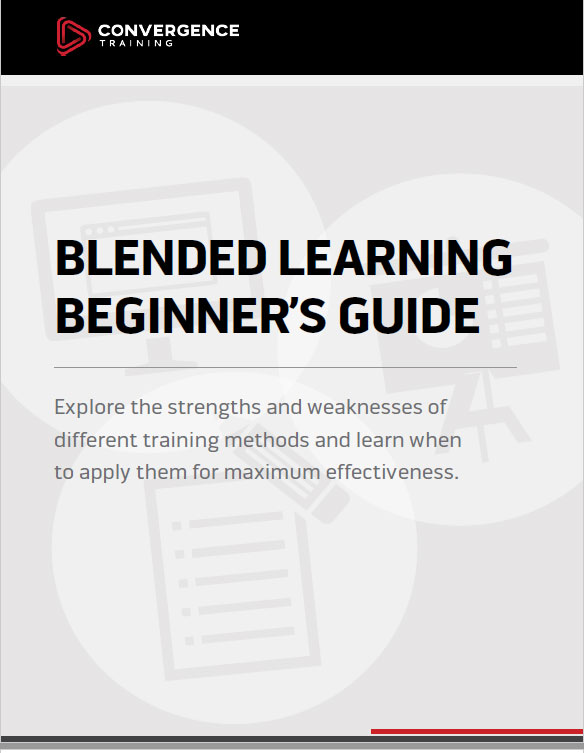 Probably the most famous “steps of training” guidance is the one created by the instructional theorist Robert Gagne. Gagne’s ideas are justly well-regarded and we’ve already written an article about Gagne’s Nine Events of Instruction. So feel free to click that link you just passed up if you’re curious.
Probably the most famous “steps of training” guidance is the one created by the instructional theorist Robert Gagne. Gagne’s ideas are justly well-regarded and we’ve already written an article about Gagne’s Nine Events of Instruction. So feel free to click that link you just passed up if you’re curious.
But in their 2003 book Writing Training Materials that Work: How to Train Anyone to Do Anything, Wellesley R. Foshay, Kenneth H. Silber, and Michael B. Stelnicki present their own, more updated steps. What makes these steps especially interesting (and I believe useful) is that they’re grounded in the field of cognitive psychology, the study of how people learn, including things like attention, thinking, memory, and problem-solving.
In this article, we’ll give you an overview of the steps, as you’d guess. And we’ll also present some additional ideas from the book. Of course, we encourage you to buy and read the book on your own, too.
- Learning Management Systems
- Online Workforce Training Courses
- Custom Workforce Training
- Incident Management Software
- Mobile Training Apps
First, 5 Steps of Learning
The three authors list five steps that learners (not trainers–that’s still to come) must perform in order to learn. And then for each of those “learner steps” they give steps of what trainers have to do to help the learner at that phase.
We’re going to start by just listing the five steps that learners have to go through. We’ll add the corresponding trainer steps shortly.
What Learners Must Do In Order to Learn
Here are the five steps that a learner goes through when learning something new:
- Focus their attention on new information
- Link the new information with existing knowledge that’s already in their long-term memory
- Organize that new information in their mind/memory in a way that matches the organization of the existing information they already have
- Fully integrate the new information with the old information, reorganizing the “information packet” in the brain that contains the memory to reflect the new, unified knowledge
- Strengthen the memory’s grasp of the new information
That’s it. Those are the steps that learners have to go through. As you can see by looking at the list, these are things the learner has to do in order, from top to bottom.
For more on this, see our How People Learn and Why People Forget Training article and our interview with Arun Pradhan on Learning to Learn.
Next, let’s turn our attention to how trainers can help learners do this.
How Trainers Can Create Five Steps of Training to Match the Five Steps of Learning
Now it’s time to look at how trainers can help learners through the five steps of learning new information.
It’s important to note that while the learners have to go through their five steps in order, there isn’t an exact order for what the trainers have to do, and this can vary in different circumstances.
Step 1, Help Learner Focus on New Information
- Direct learners’ attention to new information
- Give the “What’s in it for me?” to the learners
- Encourage the learners–tell them they can do it
Step 2, Help Learner Link New Information With Existing Information Already in Memory
- Help the learners recall any existing prerequisite knowledge that is required to build this new knowledge on
- Help learners relate the new information to any existing knowledge, essentially “linking” the two
Step 3, Help Learner Organize the Information in Memory
- Introduce the information in a diagram, flow chart, graphic organizer, or other presentation that helps learner see how the information is structured, organized, and related to other information (help the learner build a “mental map”)
- Explain the learning objectives–what knowledge and skills should the learners acquire (read this Learning Objectives article for more detailed information on this)
- Organize and present information in small, logically ordered “chunks” (read this “Chunking” article for more detailed information on this)
- Organize and format any text in training materials in a way that helps learners understand it (read this Formatting Written Training Materials article for on this topic for more detailed information on this)
- Make use of well-designed visuals to help explain new information to learners (read this 25 Graphic Design Tips article and this Matching Graphics to Training Content article for more detailed information on this)
Step 4, Help Learner Unify and Reorganize the Information in Memory
- Present the information in the way that makes it easiest to understand (the authors believe there are different types of training content, including facts, concepts, processes, procedures, principals/mental models, problem-solving, and troubleshooting, and that each type of training content calls for a different training strategy). Read the book for more detail on this, as their explanations spans at least six chapters, but you can also read this Matching Training Strategies to Training Content article to get the basics.
- Present and/or demonstrate real-life examples of the new information being applied.
Step 5, Help Learner Strengthen the New Knowledge in Memory
- Provide an opportunity for learners to practice applying the new information (let them “do it”)
- Give the learners feedback on on their practice–how they’re doing, what they’re doing right and wrong, why what they’re doing is right and wrong, answering questions, etc.
- Summarize the information and its structure again to remind the learners what they learned
- Test the learners to ensure they can meet/satisfy the learning objectives
- Make sure learners get to apply the new information on the skill so they “use it, not lose it”
- Use spaced practice to help support memory after training
Additional Thoughts about this “Steps of Creating Training” Book
So now you have seen (a) the steps the learners have to go through and (b) the steps the trainer should go through to help the learner through the learning process.
Remember that to help the learner through Learning Step 4 (help learner unify and reorganize information in memory), the trainer is supposed to present the information in the way that makes it easiest to understand. As we mentioned earlier, the authors take six or more chapters explaining how to do this, so that explanation is beyond the scope of this article. However, we’ll give you the basic idea and then we’ll give you a link to a summary of a related issue.
Applying the Steps of Training to Different Types of Training Material
The authors follow a well-established line of thought in saying that training materials present information of different types, including:
- Facts
- Concepts
- Principles and mental models
- Well-structured problem-solving
- Ill-structured problem-solving
- Troubleshooting
They then use six chapters, one chapter per type of information listed above, showing how to apply the steps of training to each of these different information types. It may sound tedious and boring at first, and to be honest, that’s what I thought initially also. But after a while, I really began to appreciate their efforts, and I learned a lot. To truly “get it,” I strongly recommend reading the book, but know that we have a similar blog post that covers a lot of this in a much shorter form–here it is.
For Additional Consideration: Dr. Will Thalheimer’s “Learning Maximizers”
One L&D researcher/blogger that I respect quite a bit is Dr. Will Thalheimer. He’s created a list of what he calls “learning maximizers” that to some degree overlaps the lists above and to another degree extends the list.
If you’re feeling especially curious and studious today, and have a few extra minutes, you could do well by reading up on Thalheimer’s Learning Maximizers.
You might also enjoy some of these interviews we’ve held with Dr. Thalheimer:
- Will Thalheimer on Spaced Learning
- Will Thalheimer on Smile Sheets
- Will Thalheimer on eLearning Effectivness
- Will Thalheimer on Learning Myths and Learning Maximizers
Conclusion: An Updated Steps of Creating Training
The theoretical strength of this book is presenting a new model for designing and delivering training in a series of steps based on cognitive psychology. For that, we applaud. The practical (and no doubt time-consuming) strength of the book is that the authors gave very realistic examples of how to apply the steps to each of the information types described above. This really helped to make their steps more concrete in my own brain.
But even if you don’t go full-bore and use their entire method, I think there’s a lot of value in going over their steps of training and seeing which things you’re doing now and which you’re not. Even at that first level, their training steps serve as a nice checklist of things you should aim to do in all your training sessions.

Blended Learning Beginner’s Guide
Learn the importance of using differing training delivery methods and get some tips for selecting the right training method for each training need.
Thanks for the article Jeff. This and your previous article on the topic are excellent. Really great explanations and reinforcement of key points.
Geoff,
Thanks for the nice words.
The book those two articles were based on (really the books, because the other borrowed a lot from Dr. Ruth Colvin Clark as well) were really excellent. It was a good reminder for me as well.
Have a good one. Cheers.
Great artical and clear key points.
Thanks, Sherin, glad you found some stuff of value here.